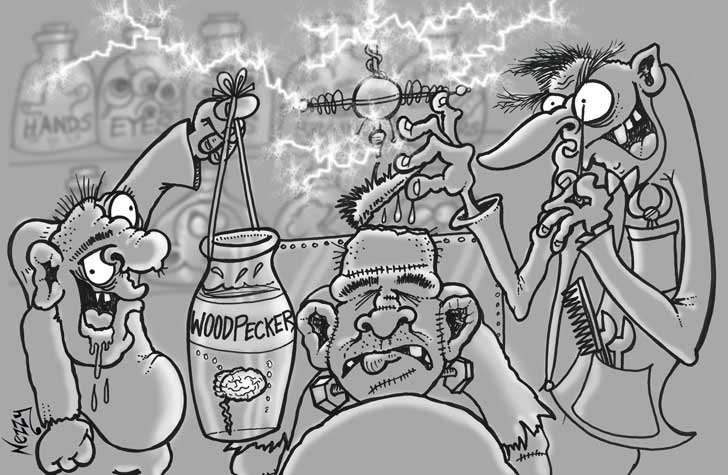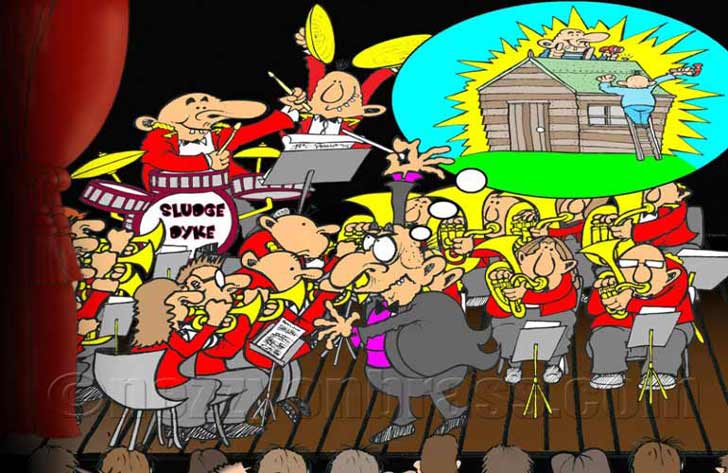Bass drum, snare drum and cymbals. The good old days?
Guestpost from John Barber – Courtesy of Brass Band World Magazine

There was a time when the domain at the back of a band room occupied little space. To sit there didn’t require a significant audition process and to be a section leader demanded no more than the basic knowledge of pulse and the ownership of a Vauxhall Cavalier Estate.
As we all know though times have changed and as composers become more and more familiar with the full range of slaps, scrapes, bangs, shakes, crashes and wallops, the previously modest commitment to feet and inches within the band room for such activity has had to be re-considered. As has the Vauxhall Cavalier.
From personal experience I can recall with a degree of surprise (and a slight feeling of ‘gosh this is awkward’) the very first time that I heard on a concert stage the men and ladies at the back of the band being openly referred to as ‘shed builders’. Certainly calling them names like this behind their backs was common place and to be expected, but to their faces? This was getting serious.
Regularly I would hear the conductor say ‘Ladies and gentlemen, our band is made up of twenty-five musicians and three percussionists’ as the hard working labourers gradually found themselves removed further and further from regular band membership.
It wasn’t as though they deserved (or continue to deserve) the twelve degrees of separation that seem to go hand in hand with owning a couple of big mallets and black Velcro stick bag deserved. This troubled me greatly – they were musicians like the rest of us weren’t they?
I recall one rehearsal working on Philip Wilby’s Paganini Variations and the frustration the conductor was experiencing as the timpanist simply couldn’t find the rehearsal spot that the ‘maestro’ wanted to go from.
‘We’re starting at rehearsal figure 10’
As we set off it was clear that the timpanist was not on script and after repeated false starts the baton was put down and the question ‘What appears to be the problem?’ was asked.
‘I don’t have a figure 10 – I’m sorry, I must have a dodgy part or summit?’
‘Are you sure certain? Let me look’.
Sure enough there was a figure 10 on the timpanist’s part. As with the rest of the parts rehearsal figures were set out in Roman Numerals. Figure 10 was marked X.
‘Oh – I wondered what those funny marks were….’
This was not a child but a fully grown member of the percussion species. I imagine he may have thought he was looking at a copy of his own signature – who knows?
Another early memory that celebrates my admiration for the percussionist species was that of their ability to communicate clearly their thoughts and questions relating to musical nuances.
‘As we approach the cadence please can we bring out the underlying dominant pedal in the timp part?’
‘What?’
‘As we approach the cadence in bar 166 please can you bring out the underlying dominant pedal in your part’
‘Nope.
Not getting it’
‘What is there not to understand’?
‘Do you want it louder?’
‘Yes please’.
‘Which one’?
‘Sorry, what do you mean which one’?
‘Which one’? (and I kid you not)
‘Bing or Bong?’
It is of course easy to insinuate that all percussionists are the same but this would clearly be unfair to at least 8% of whom have the ability to speak in fully formed sentences (although they may choose not to publicly).
In fact, in many ways the music world has been supportive of their plight even to the point of naming instruments for them in a user friendly manner.
Exhibit A, the Triangle, shaped like a triangle.
The Vibraslap – when you slap it, it vibrates. Genius.
Then there’s the Shaker which, you’ve guessed it you shake, and of course not to forget the cleverly named block of wood that is the ‘Wood Block’ (although often these days it appears in its plastic form which can be a little confusing for some…).
Of course the above is all very much in jest. Drummers, triangle players, scrapers and vibrasplappers add much to the colourful sound world of the brass band. A merry collective who occupy band room crucial space and provide a welcome home for once passionate baritone and Bb bass players who may have recently invested their retirement package in a Renault Espace.
We should be saying thank you.
 John Barber penned this article for the ‘And another thing’ feature in the October 2016 edition of Brass Band World Magazine.
John Barber penned this article for the ‘And another thing’ feature in the October 2016 edition of Brass Band World Magazine.
John is the Solo Trombone at Fodens Band and works as a teacher at a local school in Sandbach, Cheshire.
You can now get Brass Band World Magazine in digital format for your Desktop Tablet and phone. For more details and subscription rates check out Brass Band World Magazine on digital subsciption here…

